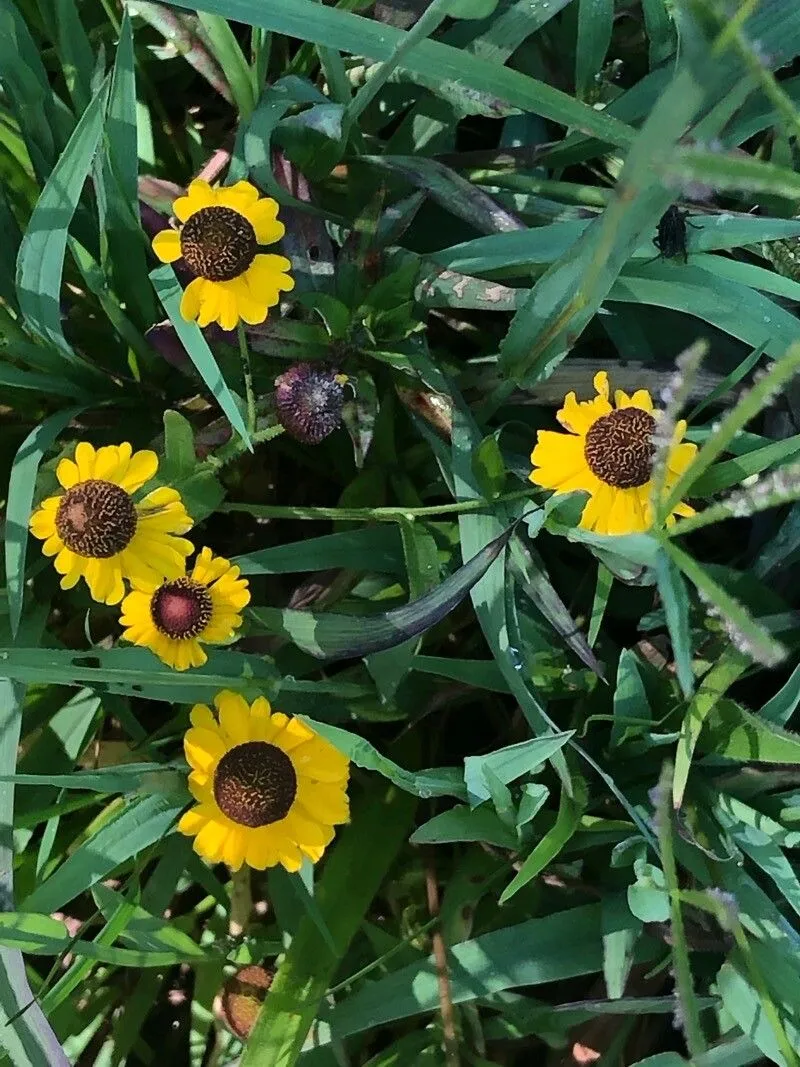
Author: Raf.
Bibliography: New Fl. 4: 81
Year: 1792
Status: accepted
Rank: species
Genus: Helenium
Vegetable: False
Observations: E. Canada to U.S.A.
The Purplehead Sneezeweed, scientifically known as Helenium flexuosum, is part of the Asteraceae family. This striking plant is most commonly found in Eastern Canada and the United States, making it a familiar sight in a range of North American habitats.
Purplehead Sneezeweed thrives in meadows, along roadsides, and in other open, sunny areas where its vibrant purple flowers can often be seen nodding gently in the breeze. This hardy plant typically flowers in late summer to early autumn, contributing a splash of color to the landscape as the season begins to transition towards fall.
Named for its distinctive bloom, the Purplehead Sneezeweed’s flower heads are composed of numerous tiny, tubular florets tightly packed together, creating a singular, dome-shaped appearance. The petals, or ray florets, surrounding the central disk flowers, range in hues of deep purple, adding a unique visual appeal.
This plant not only adds aesthetic value but also plays a role in supporting local ecosystems. The blooms attract a variety of pollinators, including bees, butterflies, and other beneficial insects, facilitating cross-pollination. In periods of early settlement, it was believed that the dried, powdered leaves of sneezeweed could induce sneezing, thereby clearing the head of congestion, which is the origin of its common name.
Despite its beauty, the Purplehead Sneezeweed is known to be toxic to livestock if ingested in large quantities. This toxicity is attributed to the presence of sesquiterpene lactones, natural compounds that protect the plant from herbivory. Care should be taken to manage this plant in grazing areas to prevent potential poisoning.
The Purplehead Sneezeweed stands out not only for its vibrant coloration and ecological contributions but also for its rich historical uses and the need for caution where livestock is concerned. Whether observed in the wild or cultivated in a native plant garden, Helenium flexuosum remains an important and eye-catching member of the Asteraceae family.
Eng: purplehead sneezeweed, purple-headed sneezeweed, southern sneezeweed, naked-flowered sneezeweed
Deu: purpur-sonnenbraut
Fra: hélénie nudiflore
En: Purplehead sneezeweed, Southern Sneezeweed, Purple-headed sneezeweed, Naked-flowered sneezeweed
Fr: Hélénie nudiflore
De: Purpur-Sonnenbraut
Taken Aug 10, 2020 by Kris Barton (cc-by-sa)
Taken Aug 4, 2019 by Lydia Fredericks (cc-by-sa)
Taken Jul 13, 2021 by Leigh Ferris (cc-by-sa)
Taken Sep 13, 2022 by chelsea lee (cc-by-sa)
Taken Aug 14, 2021 by mel O (cc-by-sa)
Taken Sep 15, 2022 by malot w (cc-by-sa)
Taken Sep 24, 2022 by RIVER STONE (cc-by-sa)
Taken Jul 31, 2021 by SCAMPS_MX (cc-by-sa)
Taken Sep 24, 2022 by RIVER STONE (cc-by-sa)
Taken Sep 24, 2022 by RIVER STONE (cc-by-sa)
Taken Jul 25, 2020 by Ken Borgfeldt (cc-by-sa)
Taken May 22, 2021 by Vinegar Karen (cc-by-sa)
Taken Jan 1, 1900 by EOL − John Hilty (cc-by-nc)
© copyright of the Board of Trustees of the Royal Botanic Gardens, Kew.
Growth form>: Multiple Stem
Growth habit>: Forb/herb
Growth rate>: Moderate
Ph maximum: 7.5
Ph minimum: 4.5
Family: Myrtaceae Author: (F.Muell.) K.D.Hill & L.A.S.Johnson Bibliography: Telopea 6: 402 (1995) Year: 1995 Status:…
Family: Rubiaceae Author: Pierre ex A.Froehner Bibliography: Notizbl. Bot. Gart. Berlin-Dahlem 1: 237 (1897) Year:…
Family: Sapindaceae Author: Koidz. Bibliography: J. Coll. Sci. Imp. Univ. Tokyo 32(1): 38 (1911) Year:…
Family: Asteraceae Author: A.Gray Bibliography: Pacif. Railr. Rep.: 107 (1857) Year: 1857 Status: accepted Rank:…
Family: Fabaceae Author: Medik. Bibliography: Vorles. Churpfälz. Phys.-Ökon. Ges. 2: 398 (1787) Year: 1787 Status:…
Family: Aspleniaceae Author: (Cav.) Alston Bibliography: Bull. Misc. Inform. Kew 1932: 309 (1932) Year: 1932…